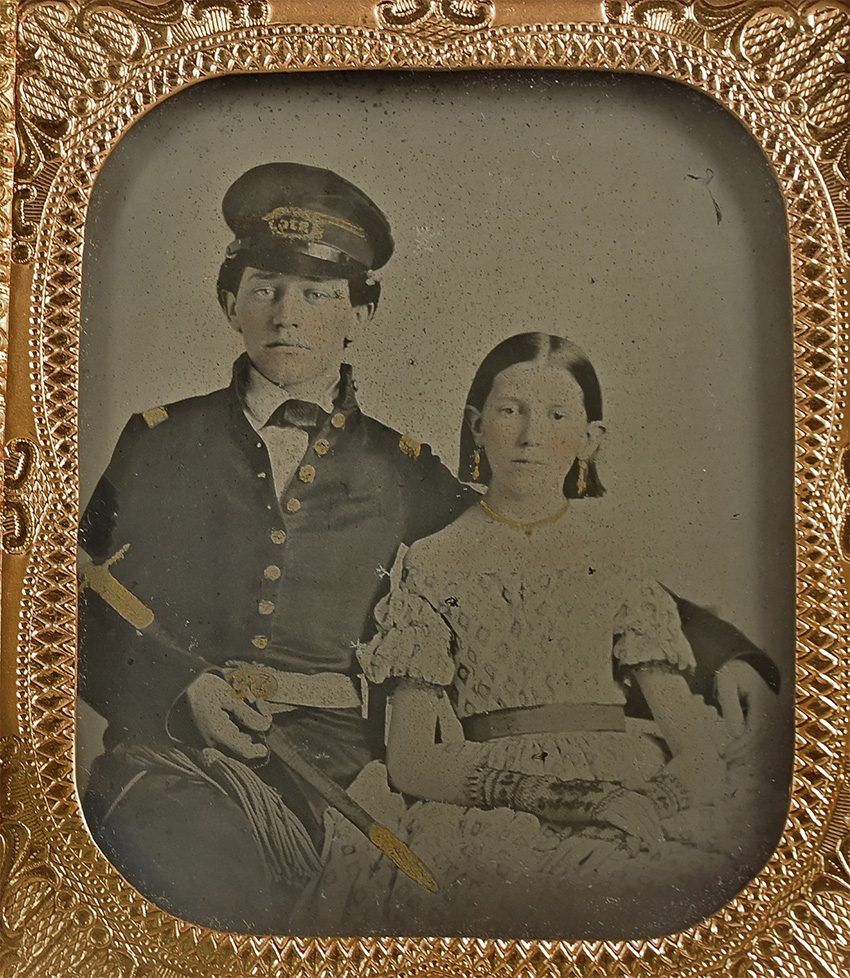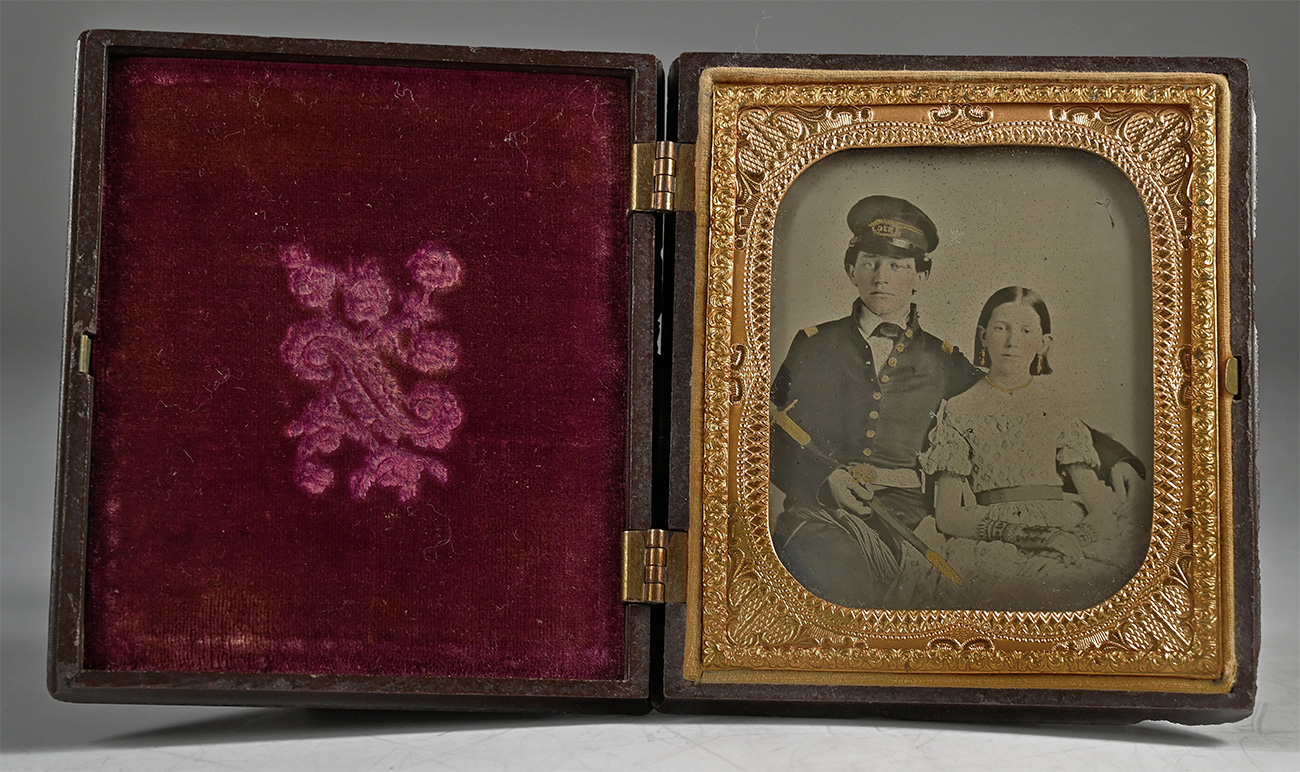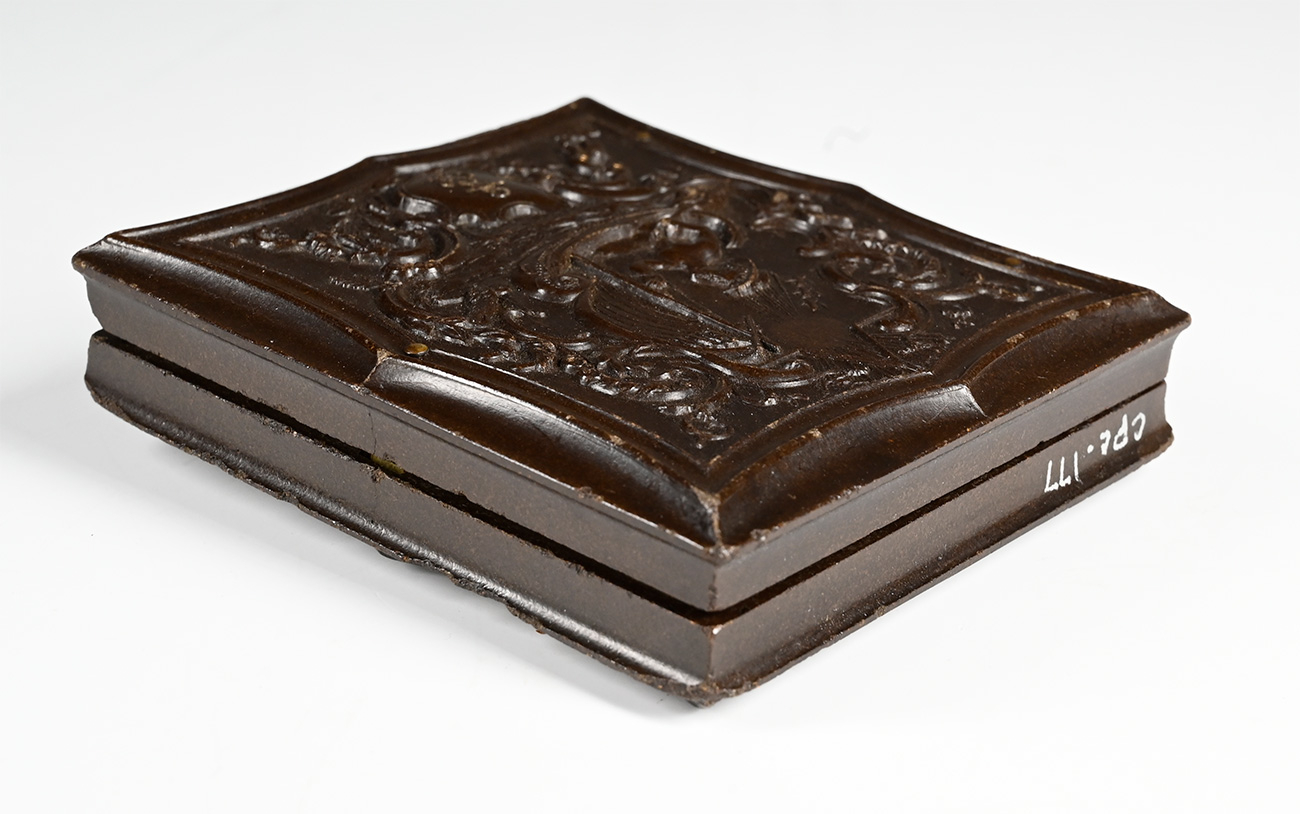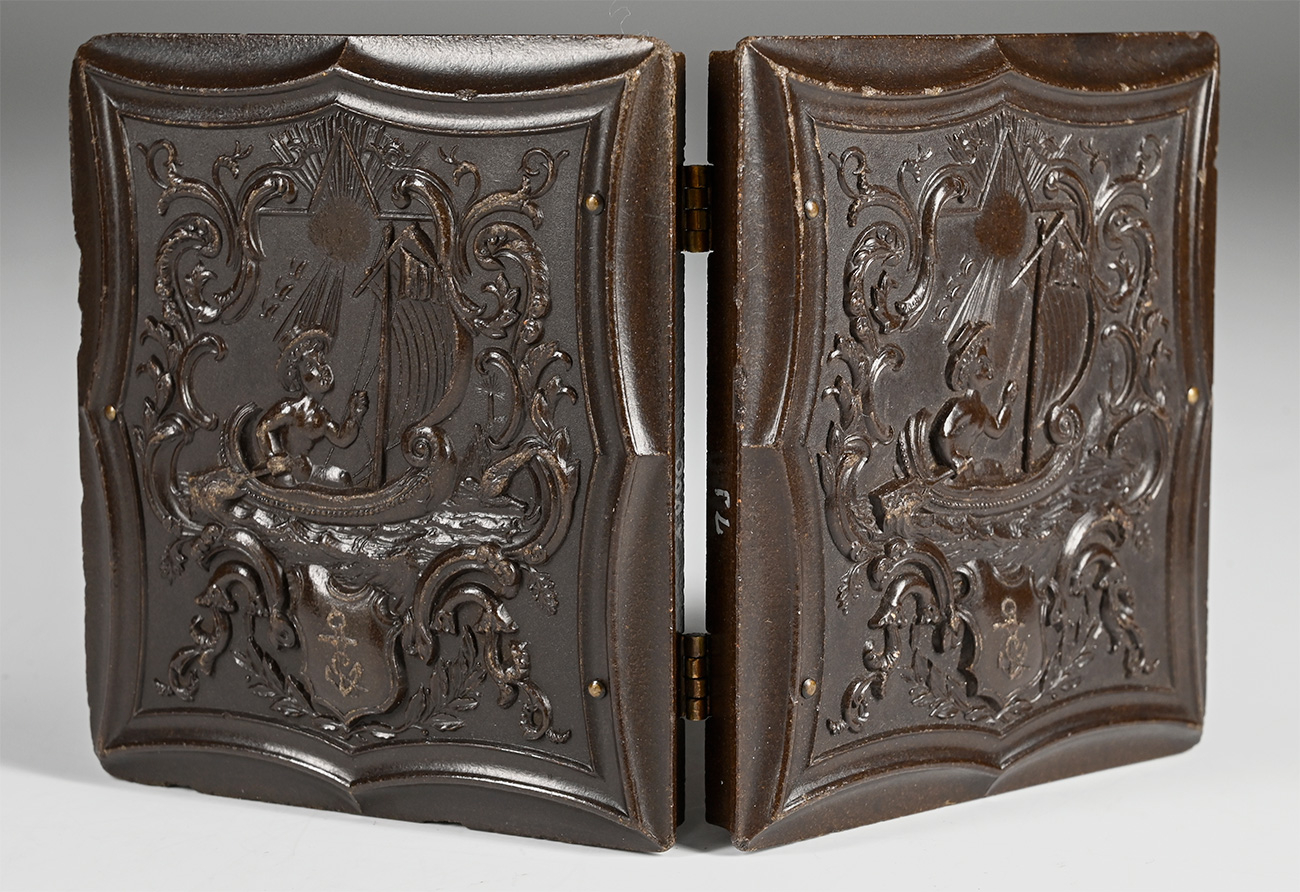site search
online catalog
SIXTH PLATE AMBROTYPE OF “DOCTOR AMISS” EX-BILL TURNER COLLECTION

Hover to zoom




$2,250.00
Quantity Available: 1
Item Code: 1138-1897
This very clear ambrotype shows a young man in officer’s uniform at left with his arm draped protectively behind a younger girl on the right. He wears an 1839 pattern forage cap and an officer’s single breasted frock coat, opened slightly to show collar and tie, with shoulder straps. He cradles an officer’s sword, which has a black leather scabbard. Only part of the grip and the quillon show: it would seem to have a white bone or ivory grip. His waist belt has an oval US plate and seems clearly to be white buff. The end of an officer’s sash is draped in his lap. The young girl is attired formally for the occasion, with earrings, necklace and lace gloves. She wears her hair straight, pushed back and oiled. Her dress has short, puffed sleeves and short waist. From their dress we would date the image about 1856-1860. The photographer has gilded the metallic elements in the photo, including the young man’s shoulders straps, hat braid and insignia, but the letters can be clearly made out as “SJG” once corrected for reversal in the image.
Bill Turner needs no introduction to collectors as one of the foremost Virginia Civil War collectors and dealers and the young man was identified in his files as “Dr. Amiss.” Virginia records give us three possible candidates, all doctors, and all from the same Rappahannock County family: William H. Amiss (1829-1903,) John B. Amiss (1834-1903,) and Thomas B. Amiss (1839-1903.) The uniform, and its implied interest in the military, throws suspicion on Thomas. He attended VMI for three years, 1855-1857, before journeying to Philadelphia to get a medical degree from UPenn. His degree was granted in March 1861, but we find he was living with several of his siblings, including sisters Nannie (age 9) and Fannie (age 12,) with his mother’s Leavell relatives, also Rappahannock County, when the census was taken in July 1860. Of course, another sister, Eliza (about 15 at the time,) can’t be ruled out as the girl in the photograph, nor can we entirely rule out half-brother William H. Amiss as the sitter: he lived in Sperryville at the time, which could tie in with the “SJG” hat insignia as designating a local militia company, but we find no good candidates for the organization in Amann’s list, and the man seems younger than 30.
John B. Amiss saw no active Confederate service, but William and Thomas both did, and are best known for a joint medical triumph in the field. At the war’s opening both brothers served briefly in the 34th Virginia Militia. William was shortly after commissioned Assistant Surgeon for the 19th Mississippi, serving in the Peninsula Campaign, and then in July was ordered to report to Hunter McGuire, Jackson’s medical director. He was transferred to the 60th Georgia officially, with whom he served to the end of the war, but in fact was detached for hospital duty in Richmond in Fall 1864. Thomas, with his military experience, spent some time drilling recruits in Rappahannock and Culpeper Counties, and then signed up as a private in the 6th Virginia Cavalry, seeing service at First Bull Run, and was then commissioned Assistant Surgeon and assigned to Bailey’s Factory Hospital in Richmond in September 1861, until commissioned Surgeon and assigned to the 31st Georgia in time for the Peninsula Campaign, seeing action later at Cedar Mountain, Second Manassas, Antietam, and Fredericksburg, but because of health problems was again assigned to hospital duty in North Carolina and then attached to a North Carolina artillery battalion, at Salisbury and then Weldon, until the end of the war. After the war both men had successful medical practices in Virginia.
Thomas and William found themselves both with Jackson’s command at Cedar Mountain and jointly saved Captain R.S. Andrews of the Maryland artillery from a gruesome abdominal wound suffered at Cedar Mountain that left his intestines exposed and full of dirt. Doctor McGuire dispatched the two brothers to look him over, though he and others had given up on Andrews as mortally wounded. Thomas Amiss at first concurred, telling William there was nothing to do for Andrews other than, “dig a hole and put him in it,” to which Andrews responded “That is what Dr. McGuire said, but if you damned doctors would do something for me I’d get well…” Given Andrews’s spirit they decided to give it a try, and Andrews actually survived, even returning to field command, though Thomas’s first reaction to Andrews’ outburst and determination to survive deserves a place in the history of puns. Turning to William, he reportedly remarked, “This man is full of all kinds of grit!”
This is a wonderful image, housed in a figural thermoplastic case showing a young boy in a fanciful small sailboat with birds overhead and the rays of the sun beaming down. The case has some minor chipping. The image is framed, matted and glassed. The velvet facing pad is intact. [SR] [ph:M]
~~~~~~~~~~~~~~~~~~~~~~~~~~~~~~~~~~~
THIS ITEM, AS WITH ALL OTHER ITEMS AVAILABLE ON OUR WEB SITE,
MAY BE PURCHASED THROUGH OUR LAYAWAY PROGRAM.
CLICK HERE FOR OUR POLICIES AND TERMS.
THANK YOU!
Inquire About SIXTH PLATE AMBROTYPE OF “DOCTOR AMISS” EX-BILL TURNER COLLECTION
Most Popular
Historical Firearms Stolen From The National Civil War Museum In Harrisburg, Pa »
Theft From Gravesite Of Gen. John Reynolds »
Selection Of Unframed Prints By Don Troiani »
Fine Condition Brass Infantry Bugle Insignia »
Large English Bowie Knife With Sheath 1870’S – 1880’S »
Imported (Clauberg) Us Model 1860 Light Cavalry Officer's Saber »
featured item
JULY 1863 LETTER BY FAMED COL. JOSHUA LAWRENCE CHAMBERLAIN OF THE 20TH MAINE
This letter comes from the hand of famed Colonel Joshua Lawrence Chamberlain of the 20th Maine and is written to his wife from his shelter tent in the Shenandoah Valley near Front Royal. Dated July 24th 1863, Col. Chamberlain details the fight of… (557-250). Learn More »


